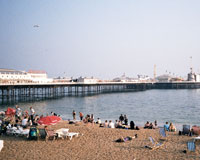 There’s inner London, there’s outer London, and now there’s outer-outer London.
There’s inner London, there’s outer London, and now there’s outer-outer London.
The mighty gravitational pull of Europe’s biggest city is dragging an ever-greater swathe of South East England into its orbit.
Today, places as far away as Oxford, Brighton, Reading and Milton Keynes are becoming part of the vast spoke-and-hub London economy. Are they now London boroughs in all but name?
There’s no doubt that “Londonification” is in progress, as data from the residential property sector seems to show. Meanwhile, cultural Londonification has been under way for decades in locations like Brighton and Oxford.
But what of the commercial property sector? Experts say there are growing signs that what were once independent sub-regional markets are now increasingly under the capital’s sway.
The Thames Valley towns are tipped as most likely to become part of outer-outer London. Fast rail journey times from Slough already give the town a distinctly west London feel. But with Crossrail coming to Slough, Maidenhead and Reading in 2018, all three could become London boroughs by default.
Matt Willcock is a director at Cushman & Wakefield and advisor to Benson Elliott and M&G Real Estate on their 373,000 sq ft Forbury Place office development, in Reading. He believes the town increasingly plays in an outer-outer London market.
“We’re focusing our marketing effort for Forbury on London and fringe London. To many, it already feels like London – it’s a quick journey on the train, and many of the huge corporate names they know are already here,” he says.
“I think we’ll see a gradual change so that many out-of-London locations will be seen as parts of one market across London. Crossrail is going to accelerate that. And these towns should welcome it, because London is doing well, why wouldn’t you want to be linked to it?”
For many occupiers, says Willcock, the name of the town matters much less than issues like commuter access and staff recruitment. With German pharmaceuticals giant Bayer looking for 80,000-100,000 sq ft in the Thames Valley or in distant Cambridge, Willcock obviously has a point.
View London Orbital locations in a full screen map
Landid director James Silver, fresh from half a dozen office purchases from Hammersmith to Reading, couldn’t agree more. The London influence is moving west in stages, he says.
“Hammersmith was once seen as a separate market, and it is now fully absorbed into the central London market, and today anything inside the M25 already feels like it’s London. Reading is still a market in its own right, it isn’t completely dependent on London, even if many of the town’s occupiers have masters or investors in London. But Crossrail is going to make Reading feel much closer, and we’ve an eye on the future,” he says.
For now Silver is watching Watford: “Potentially it’s a northern Croydon,” he says.
The further you get from London, the weaker the gravitational pull, but even Milton Keynes, 55 miles north-west, is feeling the force.
“Five years ago I’d have said no way, but today we are getting closer to London,” says Roger Yates, head of commercial at Bidwells, Milton Keynes.
“We’re already competing with outer London locations such as Watford and St Albans, and for occupiers looking at those locations, Milton Keynes looks better value. Top rents here are £21-£22 per sq ft, compared to £25 in Watford and £30 in St Albans.”
Today it is estimated that barely a fifth of the Milton Keynes occupational take-up is let after occupiers weigh-up alternative locations – but that proportion is growing and, if the town retains its competitive advantage, is sure to grow fast.
Ironically, the pull of London seems to be felt least in Oxford and Brighton, places that appear to have great cultural affinity with the capital. Metropolitan in outlook, and largely populated by London refugees or refuseniks, both locations have been outposts of London values for decades, if not centuries.
Yet according to Martin Conway, partner at Oxford surveyors Marriotts, the London effect is barely noticeable in the city’s office market.
“Of course the city has strong links to London, and if London sneezes Oxford is going to catch a cold – but Oxford still has its own market drivers, which mean Oxford can often hold steady when London is under pressure,” Conway explains.
“The strong educational sector in the city keeps up demand for office space from those who want to be close to university-related business, and we also have some important hospitals which are significant employers and attract businesses around them.”
London has always distorted the UK economy. Often it has been seen as a bad influence. But today its creeping progress across the M25 and into the South East is being met with much less resistance and – in some towns at least – muted applause.
The Orbitals
 Oxford
Oxford
Population: 150,000
Office market annual take-up: 209,588 sq ft (2013, EGi figures)
It feels like London because: Some 500 years of cultural interchange mean London and Oxford are inextricably linked. Today Oxford is as much a part of intellectual north London as Islington, Hampstead or Highgate.
It doesn’t feel like London because: A strong indigenous office market plus continuing interest from inward investors who like the environment. British Gas’s 80,000 sq ft relocation to Goodman’s Oxford Business Park is a case in point.
London assimilation rating 2/5
 Reading
Reading
Population: 318,000
Office market annual take-up: 785,098 sq ft (2013, EGi figures)
It feels like London because: Crossrail is on the way, with the first services due in 2018. Trains will not be quicker than they are today – many will be slower – but Reading will be on the London transport map. Proximity to London already means many London-linked occupiers. Jon Gardiner, regional offices director at Savills, says: “Reading is being seen as a large adjunct to London. But for it to hold its position in that market it needs to have high-quality office space, the same quality as in London.”
It doesn’t feel like London because: Reading is a regional hub, says Charlie Nicholson, head of Thames Valley business space at Vail Williams. “Reading occupiers are not just back-offices from London, but HQ buildings for Microsoft, Oracle, Prudential, Jacobs, and lots more, all multinationals not reliant on the London market. Reading is a diversified separate hub which provides a distinct appeal,” he insists.
London assimilation rating 4/5
 Milton Keynes
Milton Keynes
Population: 256,000
Office market annual take-up: 480,142 sq ft (2013, EGi figures)
It feels like London because: Lots of ex-Londoners live there – and plenty of Londoners work there, not least about 2,700 Network Rail staff whose office moved in 2011 from Euston to a 350,000 sq ft HQ next to Milton Keynes station.
It doesn’t feel like London because: It’s too far away, and the New Town flavour militates against the metropolitan feel.
London assimilation rating 2/5
 Brighton
Brighton
Population: 273,000
Office market annual take-up:121,720 sq ft (2013, EGi figures)
It feels like London because: Brighton has for decades been an unofficial South London-by-the-Sea. Meanwhile, improvements to the Bedford via London to Brighton Thameslink rail service will improve connections to the capital when completed in 2018.
It doesn’t feel like London because: The office market is still small and local. Mark Taylor, head of national offices at Colliers International, explains: “There is not much evidence of corporate activity, and it remains a peripheral office market. There is no new build.”
London assimilation rating 3/5
“Londonification”
Figures from Hamptons International suggest that about a third of Londoners buying their first property buy outside the city. This represents a 70% increase compared to 2013.
Londoners trading up in the property market are also increasingly buying in the satellite towns.
Hamptons calculates that about 58,000 homes were bought outside the Greater London limits, 50% up on 2013 and the highest since the boom of 2007.
Rightmove is predicting many more such sales in 2015.











